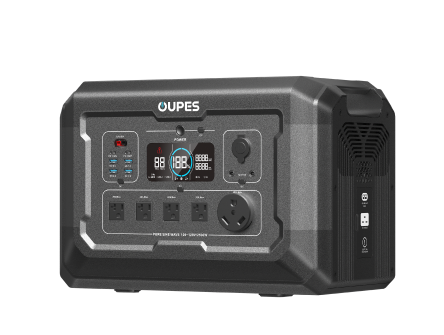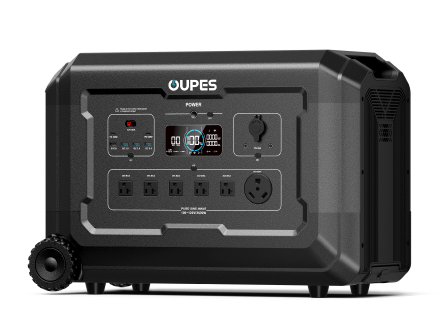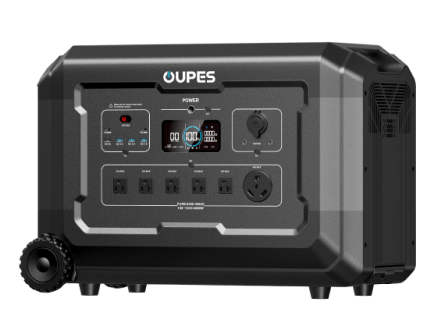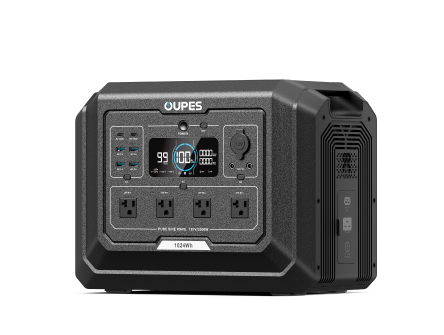
Have you ever wondered just how many appliances your portable power station can handle at once? Whether you're preparing for an outdoor adventure, a weekend camping trip, or simply safeguarding your home during a blackout, understanding your station's capacity is essential. Power stations are versatile tools, but to truly unlock their potential, it’s crucial to match your energy needs with the station's capabilities.
This guide will explore how many appliances a power station can support, what factors influence its capacity, and how you can maximize usage without overloading the system. Whether you own a compact unit or a high-capacity model like OUPES, this information will help you use your power station efficiently and safely.
Understanding Power Station Capacity and Output
To determine how many appliances your power station can support, you first need to understand its total capacity and power output. The capacity of a power station is usually measured in watt-hours (Wh), which indicates the amount of energy the battery can store. For example, a 1000Wh station can theoretically deliver 1000 watts for one hour or 100 watts for 10 hours. The higher the watt-hour rating, the longer and more numerous the devices it can support.
Equally important is the station’s inverter capacity, often represented in watts (W). The inverter converts the stored DC power into AC power, which most household appliances require. This specification determines the maximum power load the station can handle at any given time. For instance, if your station has a 1000W inverter, it can run devices up to a combined load of 1000W simultaneously.
Another key specification is surge power, which reflects the station’s ability to handle brief spikes in power demand when certain appliances start up. Appliances like refrigerators, air conditioners, and microwaves can draw two to three times their running wattage when turned on. A robust surge rating ensures the power station can handle these temporary spikes without shutting down.
By familiarizing yourself with these metrics—battery capacity, inverter output, and surge power—you can better calculate the number of appliances your station can run safely at the same time. Always ensure the combined wattage of all active devices stays within the station’s continuous output limit.
Common Household Appliances and Their Power Requirements
Knowing the power consumption of common household appliances is essential when determining how many your station can support. Appliances vary widely in their energy needs, and combining high-wattage devices can quickly exhaust your station’s capacity.
For example, smaller devices like LED lights, smartphones, and laptops are low-power consumers, typically requiring 5W to 100W each. This means that even a mid-sized power station can support several of these devices simultaneously without much strain on the system.
Medium-power appliances include items like televisions, gaming consoles, fans, and small kitchen gadgets such as blenders or coffee makers. These usually consume between 100W to 400W. Running a few of these together is feasible for a power station with a 1000W or higher output, especially if they’re not used continuously.
High-power appliances are where energy demands spike. Microwaves (800W–1200W), space heaters (1000W–1500W), and hair dryers (1000W–1800W) can quickly consume significant portions of your power station’s output. Running even one of these devices might approach or exceed the limit of smaller stations, making them better suited for higher-capacity models like those offered by OUPES.
To estimate your power needs, create a list of the devices you plan to run and check their wattage ratings, usually found on labels or in user manuals. Add up the wattages of all devices you want to use simultaneously and compare this number to your station's continuous output capacity. This ensures you won’t exceed the station’s limits, avoiding overloads and unexpected shutdowns.
By understanding each appliance's energy draw, you can strategically prioritize which devices to power together and which to alternate, ensuring your power station serves you effectively in any situation.
How to Calculate Runtime and Optimize Usage
Once you know your power station’s capacity and the energy requirements of your appliances, the next step is calculating how long each device can run. This helps you manage your power usage efficiently, especially when off-grid or during prolonged outages.
The basic formula for estimating runtime is:
Runtime (hours) = Power Station Capacity (Wh) ÷ Total Device Wattage (W)
For instance, if you have a 1000Wh power station and run a 100W appliance, you can expect approximately 10 hours of use (1000Wh ÷ 100W). Keep in mind that actual runtimes may be slightly lower due to inverter inefficiencies, typically around 85%–90% efficiency rates.
If you’re running multiple devices, simply sum their wattages. For example, a 50W laptop and a 150W TV running together require 200W. Using the same 1000Wh station, you’d get roughly 5 hours of runtime (1000Wh ÷ 200W).
To optimize usage and extend runtime:
- Prioritize essential devices such as medical equipment, communication tools, or refrigeration.
- Use energy-efficient appliances, like LED lighting instead of incandescent bulbs.
- Turn off or unplug devices when not in use to minimize phantom loads (standby power consumption).
- Charge devices sequentially rather than simultaneously when power is limited.
Additionally, advanced stations like OUPES models often come with displays or apps that monitor real-time power usage, battery levels, and estimated remaining runtime. This information empowers you to make smarter decisions about energy consumption and ensure you get the most out of every charge cycle.
Maximizing Appliance Support with Power Management Techniques
To fully leverage your power station's capabilities, employing effective power management techniques is key. Proper planning and smart usage strategies can help you run more devices without risking overloads or rapid battery depletion.
Stagger Usage: Instead of running all appliances at once, stagger their use based on priority and necessity. For example, charge electronics while cooking is not in progress, then switch to running entertainment devices afterward.
Utilize Low-Power Settings: Many appliances have energy-saving modes that reduce power consumption. Adjusting brightness settings on screens, using low heat settings on appliances, and enabling eco-modes can significantly lower wattage requirements.
Combine AC and DC Outputs: Some devices, like smartphones or USB-powered fans, can be run off the DC or USB outputs of your power station. This reduces the strain on the AC inverter and extends overall battery life.
Monitor and Adjust Load: Regularly check your station’s power usage display to see how much wattage is being consumed. If the total load approaches the station’s limit, disconnect non-essential devices to maintain stable operation.
Supplement with Solar Charging: Pairing your power station with solar panels allows you to recharge while using energy, effectively extending available power. This is especially useful in off-grid scenarios or during extended outages when grid power is unavailable.
By integrating these power management techniques, you can safely support a broader range of appliances and ensure that your power station remains a reliable resource in any setting. Whether you’re at home, on the road, or in nature, thoughtful energy use maximizes both convenience and preparedness.
Choosing the Right Power Station for Your Appliance Needs
Selecting the right power station involves more than just checking the watt-hour capacity. It’s about aligning the station’s features and output capabilities with your specific appliance needs and usage scenarios.
If your primary goal is to power small electronics like phones, tablets, and lights, a compact station with 300Wh to 500Wh capacity may suffice. These units are lightweight, portable, and perfect for short trips or emergency kits.
For users needing to run multiple medium-power devices like laptops, routers, and televisions, a mid-range station with 1000Wh to 1500Wh capacity provides a more versatile solution. This size strikes a balance between portability and power output, offering enough capacity for several hours of simultaneous use.
High-demand applications, such as running refrigerators, power tools, or medical devices, call for larger stations with 2000Wh or more. Premium models like OUPES Mega series not only offer high capacity but also robust inverter outputs, often exceeding 2000W, to accommodate heavier loads safely and efficiently.
Other features to consider include:
- Number of output ports and variety (AC, DC, USB, USB-C)
- Battery chemistry (LiFePO4 for longer lifespan and safety)
- Solar input compatibility and maximum input wattage
- Portability considerations (weight, handles, form factor)
- Real-time monitoring and smart app controls
By matching your power station to your specific energy needs and preferred appliances, you can ensure that you’re prepared for any situation—whether it’s a blackout, a weekend in the wild, or a remote job site.
Conclusion: Power More, Worry Less
Understanding how many appliances your power station can support is crucial for making the most of your investment. By knowing your station’s capacity, the energy requirements of your devices, and applying power management techniques, you can run multiple appliances confidently and efficiently.
Whether you’re relying on a compact unit for personal electronics or a high-capacity model like OUPES Mega for home backup and off-grid living, strategic planning ensures you get the power you need when you need it most. With the right station and thoughtful usage, you’ll enjoy energy independence, convenience, and peace of mind in any environment.




























